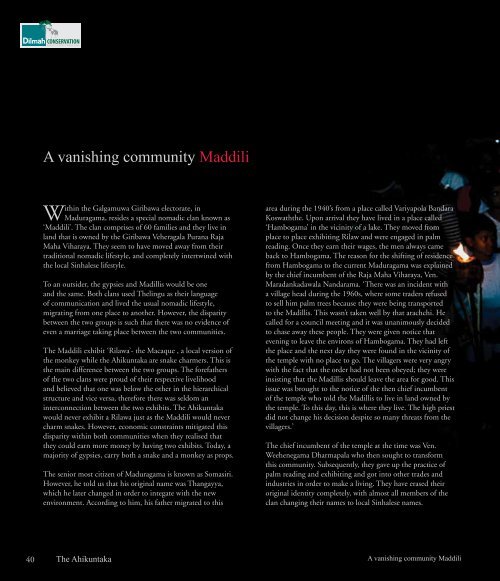The Ahikuntaka
A publication documenting the lives and livelihoods of the Ahikuntaka or gypsy community in Sri Lanka. A collection of vibrant photographs and a baseline survey on the current socio economic status of the Ahikuntaka conducted by the Colombo University complement this timely publication.
A publication documenting the lives and livelihoods of the Ahikuntaka or gypsy community in Sri Lanka. A collection of vibrant photographs and a baseline survey on the current socio economic status of the Ahikuntaka conducted by the Colombo University complement this timely publication.
You also want an ePaper? Increase the reach of your titles
YUMPU automatically turns print PDFs into web optimized ePapers that Google loves.
www.dilmahconservation.org<br />
A vanishing community Maddili<br />
Within the Galgamuwa Giribawa electorate, in<br />
Maduragama, resides a special nomadic clan known as<br />
‘Maddili’. <strong>The</strong> clan comprises of 60 families and they live in<br />
land that is owned by the Giribawa Veheragala Purana Raja<br />
Maha Viharaya. <strong>The</strong>y seem to have moved away from their<br />
traditional nomadic lifestyle, and completely intertwined with<br />
the local Sinhalese lifestyle.<br />
To an outsider, the gypsies and Madillis would be one<br />
and the same. Both clans used <strong>The</strong>lingu as their language<br />
of communication and lived the usual nomadic lifestyle,<br />
migrating from one place to another. However, the disparity<br />
between the two groups is such that there was no evidence of<br />
even a marriage taking place between the two communities.<br />
<strong>The</strong> Maddili exhibit ‘Rilawa’- the Macaque , a local version of<br />
the monkey while the <strong>Ahikuntaka</strong> are snake charmers. This is<br />
the main difference between the two groups. <strong>The</strong> forefathers<br />
of the two clans were proud of their respective livelihood<br />
and believed that one was below the other in the hierarchical<br />
structure and vice versa, therefore there was seldom an<br />
interconnection between the two exhibits. <strong>The</strong> <strong>Ahikuntaka</strong><br />
would never exhibit a Rilawa just as the Maddili would never<br />
charm snakes. However, economic constraints mitigated this<br />
disparity within both communities when they realised that<br />
they could earn more money by having two exhibits. Today, a<br />
majority of gypsies, carry both a snake and a monkey as props.<br />
<strong>The</strong> senior most citizen of Maduragama is known as Somasiri.<br />
However, he told us that his original name was Thangayya,<br />
which he later changed in order to integate with the new<br />
environment. According to him, his father migrated to this<br />
area during the 1940’s from a place called Variyapola Bandara<br />
Koswaththe. Upon arrival they have lived in a place called<br />
‘Hambogama’ in the vicinity of a lake. <strong>The</strong>y moved from<br />
place to place exhibiting Rilaw and were engaged in palm<br />
reading. Once they earn their wages, the men always came<br />
back to Hambogama. <strong>The</strong> reason for the shifting of residence<br />
from Hambogama to the current Maduragama was explained<br />
by the chief incumbent of the Raja Maha Viharaya, Ven.<br />
Maradankadawala Nandarama. ‘<strong>The</strong>re was an incident with<br />
a village head during the 1960s, where some traders refused<br />
to sell him palm trees because they were being transported<br />
to the Madillis. This wasn’t taken well by that arachchi. He<br />
called for a council meeting and it was unanimously decided<br />
to chase away these people. <strong>The</strong>y were given notice that<br />
evening to leave the environs of Hambogama. <strong>The</strong>y had left<br />
the place and the next day they were found in the vicinity of<br />
the temple with no place to go. <strong>The</strong> villagers were very angry<br />
with the fact that the order had not been obeyed; they were<br />
insisting that the Madillis should leave the area for good. This<br />
issue was brought to the notice of the then chief incumbent<br />
of the temple who told the Madillis to live in land owned by<br />
the temple. To this day, this is where they live. <strong>The</strong> high priest<br />
did not change his decision despite so many threats from the<br />
villagers.’<br />
<strong>The</strong> chief incumbent of the temple at the time was Ven.<br />
Weehenegama Dharmapala who then sought to transform<br />
this community. Subsequently, they gave up the practice of<br />
palm reading and exhibiting and got into other trades and<br />
industries in order to make a living. <strong>The</strong>y have erased their<br />
original identity completely, with almost all members of the<br />
clan changing their names to local Sinhalese names.<br />
40 <strong>The</strong> <strong>Ahikuntaka</strong><br />
A vanishing community Maddili















